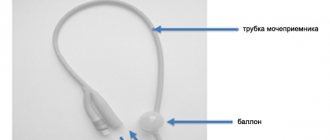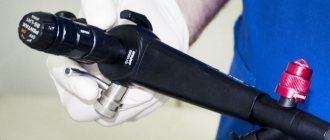CENTER FOR UROLOGY AND ANDROLOGY
8
There can be many reasons for the obstruction of urine flow from the bladder. But there are only two ways to solve this problem - a cystostomy operation or the use of a catheter that is placed in the bladder through the urethral canal.
Cystostomy is a complex surgical procedure that is also performed to drain retained urine in the body. In women in such cases, it is performed much less frequently than in men, mainly in cases where it is impossible to catheterize through the urethra. This happens as a result of previous surgical interventions or due to an injured urethra for other reasons. In men, open, puncture and trocar cystostomies are practiced.
Types of catheters
There are two types of catheters:
The Pezzer catheter is suitable for removing urine from the bladder using a fistula, which is surgically formed when there is urinary obstruction.
Foley catheter
difficult character. Consequently, this catheterization is a rather complex undertaking that requires highly qualified and experienced specialists to create a guide channel, since the catheter is installed blindly.
A Foley catheter is placed to drain the urethra directly through the canal itself. Such a latex device can be left for drainage for a period of a week, while using antibiotics or uroseptic drugs prescribed by a doctor. But no more than in time - long-term presence of this type of catheter in the urethra can provoke the development of inflammatory processes. If there is a need for longer drainage, a Foley catheter with a special coating is installed.
Statistics show that the Foley catheter, used as an instrument for cystostomy drainage, tends to become clogged much more often and cause more discomfort for the patient. But at the same time, it is the one that is given greater preference in medicine, because its removal from the ureter is painless for the patient, and the doctor has more convenience in installing and regularly checking its operation and fixation in the patient’s body.
How to properly care for your catheter
It is not worth doing independent rinsing of an installed catheter at home unless absolutely necessary. Previously, doctors recommended doing this, and gave the patient instructions for home care of the device in order to independently clean it from the formation of mucous deposits and possible blockages. But since existing bacteria quickly adapt to modern antiseptics, and their accumulations on the walls of the catheter enter the bladder during rinsing, all this can lead to infectious inflammation.
It is sufficiently clear and strictly prescribed by the doctor to replace the catheter with a new one, as well as diagnose and eliminate inflammatory processes in a timely manner.
But regular care and treatment of the skin around the cystostomy fistula with an antiseptic solution is simply necessary. Such preparations can be alcohol-based or wound-healing. After treatment, a sterile antiseptic bandage is applied to the skin of the catheter and fixed to the peritoneum using an adhesive tape.
Catheter replacement
There is no need for special conditions or complex operating equipment to replace the catheter. All you need is a new catheter and a tool to help remove the old one and install a new catheter. This can be done both in the clinic and at home, but it is clear that this procedure should only be performed by a urologist. Naturally, such manipulations are much more convenient and comfortable for the patient at home. It doesn't take long to get to the clinic,
Pezzer catheter
there is no need to wait in line in front of the doctor’s office, and, of course, there is the positive psychological factor itself - “houses and walls heal.” And you shouldn’t delay this need - a problem with genitourinary health left unattended can subsequently result in serious illnesses.
It is especially recommended to call a urologist at home if you have the following medical needs:
- replace the urethral catheter or cystostomy;
- difficulty urinating independently;
- prostatitis, cystitis in acute stages;
- BPH;
- balanoposthitis, orchiepididymitis
- urethritis of all types;
- neurogenic bladder disorders
- urolithiasis (renal colic) and other kidney diseases
A urologist is ready to come to your home for consultation, replacement of a Foley catheter, or cystostomy.
We are happy to help you 24 hours a day!
Ultrasound of the kidneys and bladder
Catheterization of a woman's bladder with a Foley catheter
Equipment: sterile catheter, two pairs of gloves (sterile and non-sterile), sterile napkins (medium 4 pcs., small 2 pcs.); sterile glycerin, syringe with 10 ml of isotonic solution; antiseptic solution; container for collecting urine.
Figure 11-13 shows the anatomical location of the urethra in a woman.
Rice. 11-13. Anatomical location of the external urethral opening
I. Preparation for the procedure
• Clarify the patient’s understanding of the purpose and course of the upcoming procedure and his consent to it. If the patient is uninformed, check with the doctor for further tactics.
• Help the patient take the position necessary for the procedure: on her back with her legs half-bent apart (frog legs pose) (Fig. 11-14).
Rice. 11-14. Bladder catheterization position
• Place an absorbent diaper (or oilcloth and diaper) under the patient’s pelvis. Place between your legs the objects necessary for hygienic treatment of the external genitalia (Fig. 11-15).
Rice. 11-15. Preparation for hygienic treatment of the external genitalia
Note. For women who are unable to spread their legs, they are bent at the knees, which also provides good access to the urethra.
• Wear gloves.
• Carry out hygienic treatment of the external genitalia, urethra and perineum (Fig. 11-16).
Rice. 11-16. Hygienic treatment of the external genitalia, urethra, perineum
• Remove gloves and place them in a waterproof container.
• Wash the hands.
• Wear sterile gloves.
• Cover the vaginal opening with sterile napkins (Fig. 11-17).
Rice. 11-17. Isolation of the vaginal opening before catheterization
Rice. 11-18. Catheter insertion
• Spread the labia minora to the sides with your left hand. With your right hand, take a sterile napkin moistened with an antiseptic solution and use it to treat the entrance to the urethra.
• Ask an assistant to open the catheter package. Remove the catheter from the package: hold it at a distance of 5-6 cm from the side hole with fingers 1 and 2, hold the outer end of the catheter between fingers IV and V.
• Ask an assistant to generously lubricate the catheter with glycerin (or a special jelly-like lubricant).
II. Executing the procedure
• Insert the catheter into the urethral opening 10 cm or until urine appears (Fig. 11-18).
Note. If the entrance to the urethra is not clearly defined, a doctor's consultation is required.
• Fill the Foley catheter balloon with 10 ml of isotonic solution.
III. Completing the procedure
• Connect the indwelling catheter to the drainage bag. Make sure the tubes are not kinked. Attach the Foley catheter tube to the thigh with adhesive tape (Figure 11-19).
Rice. 11-19. Fixing an indwelling catheter to the thigh
• Throw off the diaper, oilcloth. Remove gloves, wash hands.
• Record the patient's reaction to the procedure in the Medical Record.
Note. Empty the drainage bag and care for the perineum and indwelling catheter according to the procedures outlined below.
The Nelatonna catheter insertion technique differs from the Foley catheter insertion technique in that the Nelatonna catheter does not have a balloon. Therefore, it is never installed for a long time.
PREVENTION OF IN-HOSPITAL URINARY TRACT INFECTION IN A PATIENT WITH AN INDUSTRIAL URETHRAL CATHETER
To prevent hospital-acquired urinary tract infection in a patient with an indwelling catheter, the following conditions should be observed.
• Insert the catheter, strictly observing the rules of asepsis, using atraumatic methods.
• Securely secure the catheter to prevent it from falling out of the urethra.
• Keep the catheter in place no longer than necessary.
• Use an external catheter if possible (in men).
• Wash your hands before and after any manipulation of the catheter and urine bag.
• Make sure that the catheter-urinal system is closed; disconnect it only if it is necessary to flush the catheter.
• Flush the catheter only if blockage is suspected.
• If it is necessary to flush the catheter, follow all the rules of asepsis.
• If it is necessary to take a urine sample for analysis, disinfect the free end of the catheter or its outlet with an antiseptic agent, and aspirate the urine using a sterile needle and syringe.
• Carefully disconnect the urine bag, avoiding contamination of the connecting tube.
• Maintain a constant flow of urine.
• Place the urine container below the level of the bladder.
• Do not pinch the catheter.
• Wash the area around the catheter with mild soap and water twice daily (Figure 11-20).
To prevent nosocomial infection in a patient with an indwelling urinary catheter, careful care should be taken of the patient's perineum and the inserted catheter.
Caring for the perineum of a patient with a urinary catheter
Equipment: terry cloth mittens, towel, gloves, absorbent diaper (oilcloth and regular diaper), water container, cotton balls.
Rice. 11-20. Washing an indwelling catheter
I. Preparation for the procedure
• Explain to the patient the purpose and course of the upcoming procedure and obtain his consent.
• Wear gloves. Place an absorbent diaper (oilcloth and diaper) under the patient’s buttocks.
• Lower the head of the bed.
• Ask the patient (help him if necessary) to take the desired position: on his back with his knees bent and legs apart.
II. Executing the procedure
• Wash the perineum according to the accepted method (for women - from front to back).
• Wash with cotton swabs and then dry 10 cm of the catheter from the area where it exits the urethra.
• Inspect the urethral area around the catheter to make sure there is no urine leakage.
• Examine the skin of the perineum for signs of infection (hyperemia, swelling, maceration of the skin, purulent discharge).
III. Completing the procedure
• Make sure that the catheter tube is taped to the thigh and not under tension.
• Make sure the drainage bag is attached to the bed.
• Remove the diaper (oilcloth with diaper) from the bed and throw it into a waterproof bag.
• Remove gloves, wash hands.
• Make a record of the procedure performed. Report to the doctor about signs of inflammation in the perineal area. An indwelling catheter (Foley), as a rule, is inserted into a seriously ill person (after surgery, with a spinal injury with spinal cord damage, in an unconscious state, etc.).
A seriously ill patient is at high risk of developing nosocomial infections, including urinary tract infections. In this regard, a patient with an indwelling catheter requires careful care.
The risk of infection associated with the use of a catheter increases every day by 5-8%, starting from the moment of catheterization and is almost inevitable with long-term catheterization, although patients often do not experience constant signs of infection. Microorganisms form developing colonies on the surface of the catheter in the form of a “biofilm”, which is difficult and sometimes impossible to remove.
Microorganisms gain access to the urinary tract in two ways:
• through the lumen at the junction of the catheter and the urinal (Fig. 11-21);
• along the outer surface of the catheter.
Rice. 11-21. Bag emptying valve
POSSIBLE DISORDERS IN THE OPERATION OF THE “CATHETER-DRAINAGE BAG” SYSTEM, THEIR REMOVAL
There is no drainage (outflow) of urine:
• check that the system pipes are not kinked;
• find out if the patient is constipated. Check the condition of the catheter:
• whether there are any formations on it that change the patency of the system.
Blood in the urine (hematuria):
• a small amount of blood may be caused by trauma during catheterization or a urinary tract infection;
• If you have a large amount of blood in your urine, tell your doctor immediately.
Urine leakage past the catheter:
• check that the system pipes are not twisted;
• determine if the patient is constipated;
• replace the catheter, inspect it for the formation of urinary stones;
Rice. 11-22. Fixing the drainage bag to the leg
• increase the patient's fluid intake to reduce concentrations;
• check whether the patient has persistent signs of a urinary tract infection;
• tell your doctor about any changes you find. Pain in the bladder area:
• Replace the catheter you are using with a smaller catheter.








